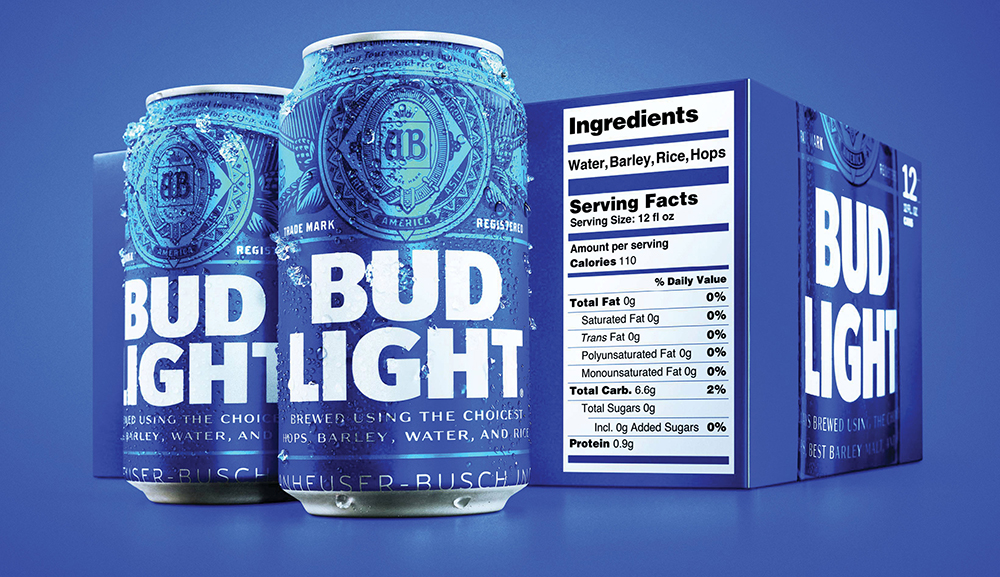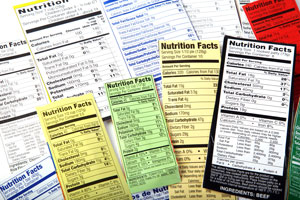Labels Address Transparency, Convenience and Compliance
- Published: May 09, 2019
By Gary Paulin and Mark Lusky
 Budweiser has been promoting that its ingredients are listed front and center on the label, and claiming Coors Light drinkers have to drill down to a website PDF to get detailed information. The basis of this ad campaign is that Bud contains no corn syrup, while Coors Light does.
Budweiser has been promoting that its ingredients are listed front and center on the label, and claiming Coors Light drinkers have to drill down to a website PDF to get detailed information. The basis of this ad campaign is that Bud contains no corn syrup, while Coors Light does.
This demonstrates why full disclosure on the label itself is worth considering—both because consumers may not want to search to find the information and/or the label content makes a powerful marketing case for (or against) a particular product.
Once upon a time, getting people to scan a QR code or input a web address from a label was novel. This label addition opened up a wide world of potential information and transparency about product ingredients, healthiness and the like.
Now, it seems that digital overload is causing consumers to want information the “old-fashioned” way—front and center on a legible label. More in-depth information can be disclosed via a link to a digital site, but get the basics handled on first glance.
Beer and wine manufacturers increasingly are jumping on the labeling disclosure bandwagon to address anticipated compliance, transparency and convenience. Ostensibly, that was the basis of the Bud Light campaign. These three factors make a compelling case for labels that disclose everything reasonably possible—in something larger than two-point type, please! (Of course, fitting ever-increasing volumes of information on a label requires creative structuring so as not to make people squint, wince and groan.)
Compliance coming to concerned consumers
A Beveragedaily.com article frames the discussion about coming alcohol compliance on labels, partly in response to consumer demand: “Nutrition labelling in alcohol: 'It's only a matter of time before nutritional labelling on-pack becomes law'…While almost every packaged food is required to have a nutritional facts label, indicating the serving size and the nutritional value per serving, alcoholic drinks do not…Any dieter will tell you that alcohol is ‘liquid sugar’, with little nutritional value and it is very easy to under estimate the calorie value in a beer, wine or spirit. The current ‘war on sugar’ and general interest in healthier eating, means this is changing as consumers are increasingly keen to know the nutritional and calorific value of all the food and beverages they consume.”
One solution: larger labels
Developing larger labels is one obvious option. In February, Anheuser-Busch’s Bud Light debuted larger-format beer nutrition labels. According to liquor.com, Bud Light’s new comprehensive nutrition label features, “serving size, calories, total fat, saturated fat, trans fat, carbohydrates, sugars and protein. The new packaging also prominently displays Bud Light’s four ingredients—hops, barley, water and rice…Breweries aren’t legally required to include these labels, but brands like Heineken and Coors Light have been printing calories and other nutrition information on packaging for years. The difference in Bud Light’s packaging is the large size of the label and the comprehensive breakdown.”
Labels also get consumers buzzing
A dAge Magazine and other media have reported on beer wars ultimately tying back to labels and what nutritional information should be on them. This in turn fuels consumer buzz and heightens awareness about what people want to know on their labels. Notes AdAge: “The beer-corn war escalates as bud light fires back at millercoors…the fact that both brewers are keeping the fight alive shows that each side thinks they are winning. MillerCoors, through its messaging, seems pleased it has the ag industry on its side, while Bud Light seems determined to keep hitching its competitors to the words ‘corn syrup,’ and now ‘dextrose,’ in a calculation that the mere mention of it is a turnoff to consumers, no matter how MillerCoors actually uses it.”
dAge Magazine and other media have reported on beer wars ultimately tying back to labels and what nutritional information should be on them. This in turn fuels consumer buzz and heightens awareness about what people want to know on their labels. Notes AdAge: “The beer-corn war escalates as bud light fires back at millercoors…the fact that both brewers are keeping the fight alive shows that each side thinks they are winning. MillerCoors, through its messaging, seems pleased it has the ag industry on its side, while Bud Light seems determined to keep hitching its competitors to the words ‘corn syrup,’ and now ‘dextrose,’ in a calculation that the mere mention of it is a turnoff to consumers, no matter how MillerCoors actually uses it.”
And the buzz continues to ramp up right along with legal action. “MillerCoors sues Anheuser-Busch for controversial Bud Light Super Bowl ad…The lawsuit is the latest retaliation from the U.S. subsidiary of Molson Coors Brewing for the Bud Light campaign that shamed Miller Lite and Coors Light for using corn syrup. Backlash from both the targeted brewer and corn industry growers followed. After the ad aired, MillerCoors said that none of its final products contain the ingredient, which is used during the brewing process,” noted CNBC in a March story.
This will fuel consumer debate and discussion, and in all likelihood brewer interest in amping up ingredient and process disclosures. Just how big labels will need to be is anyone’s guess. Perhaps we’ll start seeing extended content labels that offer comprehensive disclosure without having to go digital to get the info.
Ever-widening consumer insistence on labels with more information is—and will continue—running headlong into ways to provide needed content and graphics without creating packaging nightmares. And, it all needs to be done without forcing consumers to consider bionic eyesight to decipher tiny type.
About the author:
Gary Paulin is director of sales and customer service at Lightning Labels, a Denver-based custom label printer that uses state-of-the-art printing technology to provide affordable, full-color custom labels and custom stickers of all shapes and sizes.
Mark Lusky is president of Lusky Enterprises, Inc., a marketing communications and content development company. Contact: sales@lightninglabels.com; 800.544.6323 or 303.481.2304.










